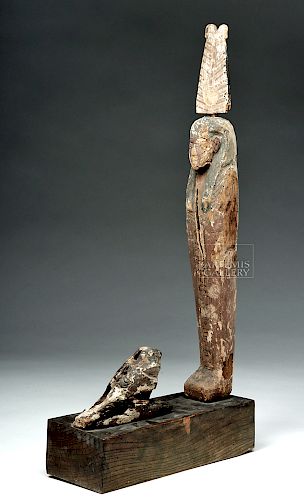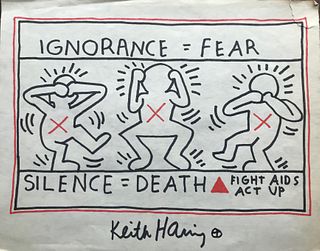Egyptian Wooden Ptah Sokar Osiris & Sokar
Lot 60d
About Seller
Artemis Fine Arts
686 S Taylor Ave, Ste 106
Louisville, CO 80027
United States
Selling antiquities, ancient and ethnographic art online since 1993, Artemis Gallery specializes in Classical Antiquities (Egyptian, Greek, Roman, Near Eastern), Asian, Pre-Columbian, African / Tribal / Oceanographic art. Our extensive inventory includes pottery, stone, metal, wood, glass and textil...Read more
Categories
Estimate:
$2,000 - $3,000
Absentee vs Live bid
Two ways to bid:
- Leave a max absentee bid and the platform will bid on your behalf up to your maximum bid during the live auction.
- Bid live during the auction and your bids will be submitted real-time to the auctioneer.
Bid Increments
| Price | Bid Increment |
|---|---|
| $0 | $25 |
| $300 | $50 |
| $1,000 | $100 |
| $2,000 | $250 |
| $5,000 | $500 |
| $10,000 | $1,000 |
| $20,000 | $2,500 |
| $50,000 | $5,000 |
| $100,000 | $10,000 |
| $200,000 | $20,000 |
About Auction
By Artemis Fine Arts
May 10, 2018
Set Reminder
2018-05-10 10:00:00
2018-05-10 10:00:00
America/New_York
Bidsquare
Bidsquare : Fine Ethnographic / Asian / Ancient Art
https://www.bidsquare.com/auctions/artemis-gallery/fine-ethnographic-asian-ancient-art-3213
Featuring antiquities from around the world including Pre-Columbian, Tribal, Classical, Asian, so much more! Artemis Fine Arts info@artemisgallery.com
Featuring antiquities from around the world including Pre-Columbian, Tribal, Classical, Asian, so much more! Artemis Fine Arts info@artemisgallery.com
- Lot Description
Ancient Egypt, Late Dynastic to Greco-Roman periods, ca. 712 to 30 BCE. An amazing, rare artifact from a culture whose enigmatic funerary rituals hint at a truly lost way of life, this is a painted and gessoed wood (probably sycamore based on similar examples) statuette depicting Ptah-Sokar-Osiris in his human-faced form; originally he would have stood atop a wooden box (as the modern base here replicates) that represents a coffin. The lid of the box would have been a slot that slid out from the top of the box, and the handle - present here - is a figure of the god Sokar in his hawk form. Size of Osiris: 2.9" W x 20.55" H (7.4 cm x 52.2 cm); size of Sokar: 6.4" L x 2" W x 3.55" H (16.3 cm x 5.1 cm x 9 cm); size of base: 4.1" L x 11.85" W x 3" H (10.4 cm x 30.1 cm x 7.6 cm)
The figure has a separate headdress that slots into the top of the head; it is in the form of a sun-disc with two plumes. It may at one time have had horns based on similar figures. The mummiform figure is painted brilliantly with red, white, and brown decoration of the body around a long, vertical panel of hieroglyphs. If the paint on Sokar was clear, you could see that he, too, is depicted as mummified, with only his head exposed.
Ptah Sokar Osiris is one of the most complicated concepts of Egyptian mythology. The figures shown here represents the god's three parts: Ptah, the creator god of Memphis; Sokar, the patron of the Memphite necropolis, and Osiris, the god of the afterlife and and lord of the underworld. All three are depicted in mummy forms; Osiris and Ptah as men, and Sokar as a falcon. Osiris is no longer present in this example, but would have been kept as a mummy - made of vegetable matter - inside the original coffin-like box. Together, they tell a story of birth, death, and resurrection. These figures became popular after ca. 1000 BCE and are associated with elite burials. In each, the god stands atop a box with a simple lid; a linen-wrapped mummy made of vegetable matter would be placed into the hollow box to represent rebirth in the afterlife (the earliest examples instead had funerary papyri placed inside of them). This "mummy" was a substitute image of the deceased, and when it sprouted, it would symbolize rebirth. The entire artifact, as this one once was, would be painted with rich colors, and decorated with hieroglyphics. Items like these were almost certainly made by priests as part of the funerary ritual. This figure represents the complex religious iconography of ancient Egypt and also serves as a good example that this religion and culture was not unchanging over the vast time period that it lasted; instead, new practices and gods arose over time.
Provenance: private Healy collection, Studio City, California, USA, acquired over the last twenty years
All items legal to buy/sell under U.S. Statute covering cultural patrimony Code 2600, CHAPTER 14, and are guaranteed to be as described or your money back.
A Certificate of Authenticity will accompany all winning bids.
We ship worldwide and handle all shipping in-house for your convenience.
#132325Osiris and Sokar are on a modern base. Both have some losses and inactive insect damage as shown. Nice remaining pigment, especially on the Osiris. Really well preserved for wood of this age.Condition
- Shipping Info
-
All shipping is handled in-house for your convenience. Your invoice from Artemis Gallery will include shipping calculation instructions. If in doubt, please inquire BEFORE bidding for estimated shipping costs for individual items.
-
- Buyer's Premium



 EUR
EUR CAD
CAD AUD
AUD GBP
GBP MXN
MXN HKD
HKD CNY
CNY MYR
MYR SEK
SEK SGD
SGD CHF
CHF THB
THB



















